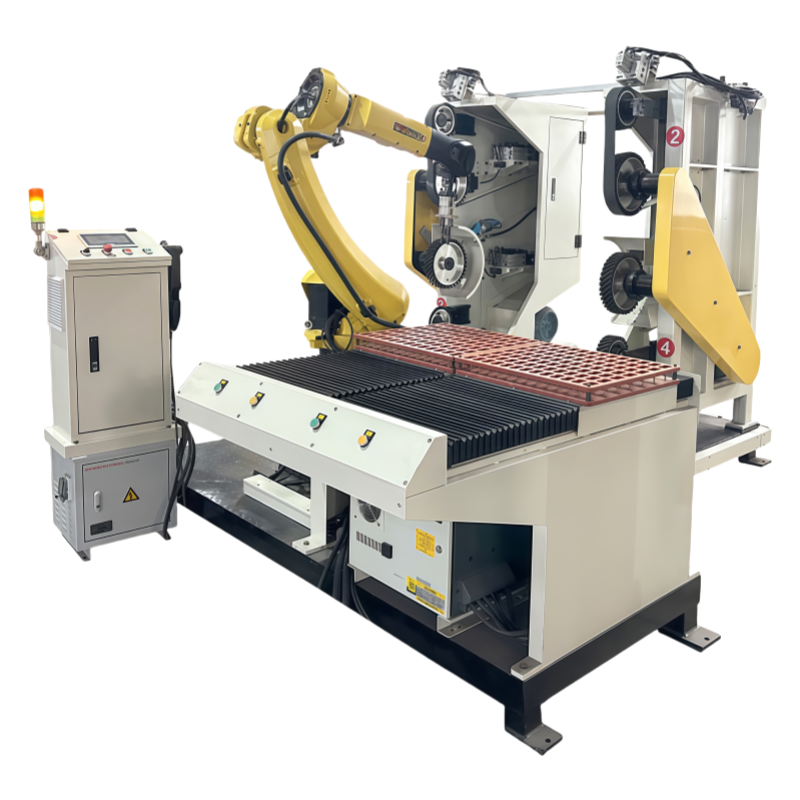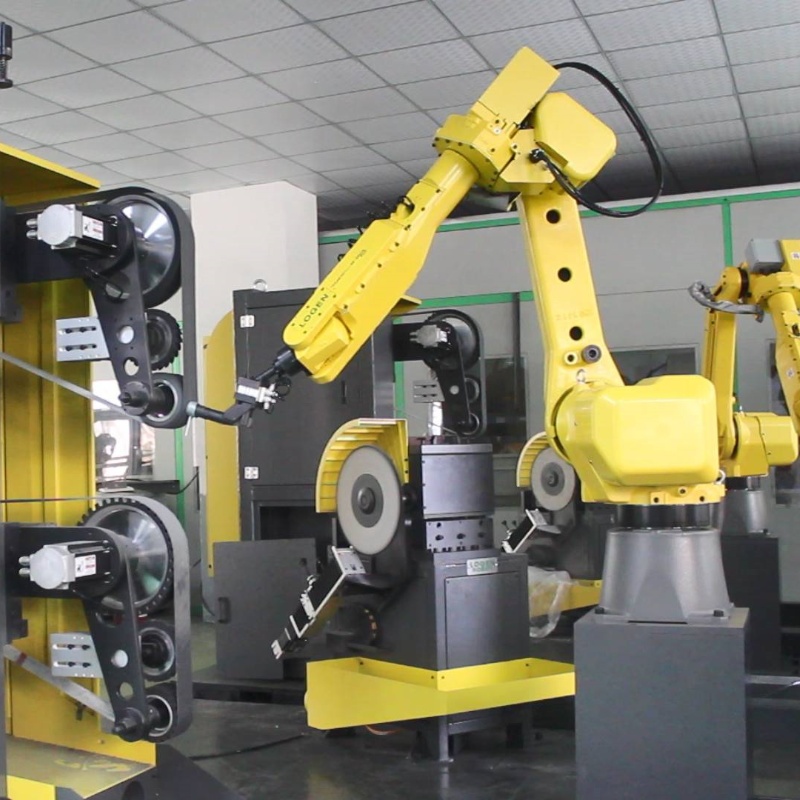FANUC Polishing and Grinding Robot Cell for Automotive Components is an advanced automated system designed to perform grinding, sanding, deburring, polishing, and buffing on automotive parts with precision and efficiency. This robot cell is specifically tailored for high-volume automotive manufacturing, where consistency, speed, and surface quality are critical.

Key Functions of FANUC Polishing and Grinding Robot Cell:
Grinding:
Purpose: Grinding is used to remove material from automotive components, correcting dimensions and smoothing rough surfaces.
Process: The robot cell utilizes grinding tools such as abrasive wheels or belts to shape and smooth the workpieces, ensuring they meet specified tolerances.
Benefits: This function helps achieve the correct size, contour, and surface finish for various automotive parts like engine components, chassis parts, and trim pieces.
Sanding:
Purpose: Sanding removes smaller surface imperfections, such as scratches or rough textures, to prepare the surface for further finishing.
Process: The robot utilizes sanding discs or belts with varying grit levels, progressively refining the surface to achieve a smooth finish.
Benefits: Ensures a uniform and fine surface quality, making it ready for polishing or other treatments.
Deburring:
Purpose: Deburring removes sharp edges, burrs, or excess material that could impact the function or safety of automotive parts.
Process: The robotic system employs specialized deburring tools such as brushes, abrasives, or rotary discs to safely eliminate burrs and edges.
Benefits: Reduces the risk of injury, enhances part functionality, and improves the aesthetic quality by eliminating rough edges.
Polishing:
Purpose: Polishing creates a smooth, glossy finish by eliminating fine scratches and imperfections, enhancing the part’s appearance.
Process: The robotic polishing heads use polishing pads, compounds, or cloths to achieve a shiny, reflective finish.
Benefits: Ideal for parts that require a high-quality surface finish, such as trim components, badges, or high-visibility parts in automotive design.
Buffing:
Purpose: Buffing is the final step that provides an even higher level of smoothness and gloss.
Process: Soft buffing pads and compounds are used by the robotic cell to give parts a mirror-like finish.
Benefits: This function is critical for creating a flawless, glossy finish on visible parts such as exterior trim, mirrors, or decorative features.
Process Workflow of FANUC Polishing and Grinding Robot Cell:
Part Loading:
Parts are placed into the robotic cell manually or automatically, depending on the system configuration. Typically, automotive components like engine blocks, transmission parts, or trim pieces are loaded.
Grinding:
Sanding:
Deburring:
Polishing:
Once the part is prepped, polishing is done to give it a smooth, shiny finish, which is essential for both aesthetic purposes and functional applications.
Buffing:
Quality Inspection:
Part Unloading:
Advantages of FANUC Polishing and Grinding Robot Cell:
Consistency: The automated robotic system ensures each part is processed with the same precision, providing consistent quality across large batches.
Efficiency: High-speed, continuous operation allows for faster production cycles, reducing downtime and increasing throughput.
Precision: FANUC robots are highly accurate, ensuring parts are ground, sanded, deburred, polished, and buffed to exact specifications.
Cost-Effective: Reduces the need for manual labor, improving overall operational efficiency and reducing costs in the long term.
Safety: Automating potentially hazardous processes like grinding and deburring improves workplace safety by minimizing operator exposure to dangerous tasks.
Versatility: The robot cell can be adapted for various automotive components, from small trim parts to large structural components.
Quality Control: With integrated sensors or vision systems, the system can monitor part quality in real time, ensuring that all parts meet stringent automotive industry standards.
Applications:
Automotive Components: Engine parts, transmission components, trim pieces, body panels, exhaust systems, mirrors, handles, and decorative elements.
Metal and Plastic Parts: Suitable for metal-based or plastic parts commonly used in automotive manufacturing.
Conclusion:
The FANUC Polishing and Grinding Robot Cell is a comprehensive solution for the automotive industry that automates the grinding, sanding, deburring, polishing, and buffing of parts. It offers a high level of precision, efficiency, and consistency, making it ideal for automotive manufacturers who require high-quality surface finishes for their components. Whether it's for enhancing the appearance of trim pieces or ensuring the smoothness of engine parts, this system is designed to meet the rigorous demands of modern automotive production.










